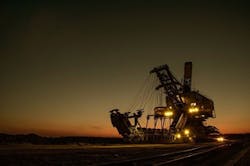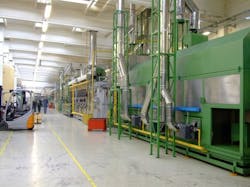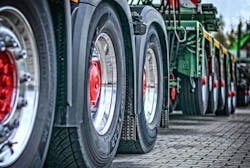The global equipment lease market is flourishing. According to the annual “2019 Global Leasing Report” published by White Clarke Group:
- The top 50 countries reported a 16.6% growth in the new business volume, rising from $1,099.77 billion in 2016 to a remarkable $1,282.73 billion in 2017.
- North America (the U.S., Canada, and Mexico) was the largest regional leasing market with a new business volume of $445.9 billion, representing 34.8% of the total global market share.
For many businesses, especially small and medium ones, leasing is a more affordable and flexible option compared to traditional banking for buying the equipment. Further, technology is making leasing industry a lot more transparent and efficient. Most companies now use sophisticated leasing software to calculate your lease duration, monthly payments, interest, maintenance, equipment use, and other factors.
However, different types of equipment leases offer a vast array of equipment on rent. So, securing a suitable equipment lease can be challenging, especially for beginners. Knowing the various features of the main types of equipment leases will help you make an informed decision.
Equipment leasing (Credit: Pixabay)
Capital Lease vs. Operating Lease
All types of equipment leases usually fall under two broad categories: capital and operating leases. In a capital lease, you (lessee) have to bear the burden of managing the asset, including paying necessary insurance and taxes. This arrangement is suitable for leasing equipment that you want to use in the long run and own when the lease ends.
In an operating lease, on the other hand, the lessor retains ownership of the equipment and all the pertaining obligations. It is suitable for leasing equipment with a short lifespan that you want to replace (with better version) when the lease ends.
Type of Equipment Lease
These two broad equipment lease categories can further be divided into the following five types.
$1 buyout lease. The $1 buyout lease is a type of capital equipment lease. In this lease, you can make fixed monthly payments as per the contract and buy the same equipment at the end of the lease for just $1.
Capital equipment leasing (Credit: Pixabay)
For example, if there is equipment worth $1,000, you can pay 10 fixed monthly installments of $99.9 and a $1 for the buyout at the end. Thus, the bulk of the equipment’s cost gets paid during the term of the lease.
In other words, buyout lease is a type of loan where the lessee (you) is considered the owner of the equipment. As a result, the equipment will show up on your balance sheet as an asset while the lease will show up as a liability. You can claim the depreciation on the equipment. However, it may not qualify under IRS regulations for tax deduction.
When to use it: If you don’t want to pay a lump-sum amount at the end of the lease and want to own the equipment guaranteed, go for this lease.
10% purchase option lease. The 10% purchase option lease is similar to the $1 buyout lease; the only difference is at the amount you have to pay at the end of the contract. In this case, you will be paying 10% of the equipment’s original value instead of just $1.
Thus, for $1,000 worth equipment, you will be paying ten installments of $90 each, and $100 at the end of the lease. In short, your fixed monthly payment will be lower than the $1 buyout lease. But, the last payment will be substantial.
When to use it: If you are not sure whether or not you should buy the equipment at the end of the lease. You can walk away from the lease without owning the equipment while saving 10% of the original equipment’s value. It’s a lot of money if you are leasing items worth hundreds of thousands.
FMV lease. A fair market value (FMV) lease is an operating lease, so it will not appear on your balance sheet and you don’t enjoy the benefits or carry the responsibilities of ownership. The monthly payments, however, are deductible as a business expense (rent) under the IRS regulations.
Usually, the term of the FMV lease is not more than 75% of the equipment’s expected lifetime. The monthly payments also don’t exceed 90% of the fair market value of the equipment considering the increasing cost of borrowing. At the end of the contract, you have the following three options:
- Buy the equipment at the fair market value (which the leasing company determines)
- Renew the lease
- Return the equipment to the lessor
When to use it: It is suitable for equipment that may lose value over time or become obsolete. You can replace the equipment or continue the lease, depending on the market condition.
10% PUT lease
A 10% puchase upon termination (PUT) lease is the same as the 10% purchase option lease, with one big difference: The 10% at the end is not an alternative. In other words, when signing this contract, you agree up front to purchase the leased equipment for 10% of its original value at the end of the term.
This type of lease provides a middle ground for the lessor and the lessee. While the lessee enjoys lower monthly payments compared to a $1 buyout lease, the lessor gets a guaranteed sale at the end of the term. It is a capital equipment lease.
When to use it: It is a better option than a traditional $1 buyout lease if you are completely sure about keeping the equipment eventually.
TRAC lease. A terminal rental adjustment clause (TRAC) lease is usually used for leasing heavy vehicles such as trucks, tractors, and trailers. It is a tax-oriented lease. It can work like a PUT lease or an FMV lease.
TRAC lease (Credit: Pixabay)
Both the lessor and the lessee agree to pay an estimated residual value, or TRAC value, which the lessee has to pay to the lessor at the end of the term. The TRAC value is inversely proportional to the fixed monthly payments. Normally, higher TRAC value leads to lower monthly payments and vice-versa.
When the term ends, the lessee has the following two options:
- Buy the equipment for the TRAC amount
- Continue the lease with corresponding adjustments
If neither option works out, the lessor (owner) will try to sell the equipment for a higher value than the TRAC amount in the market. In this case:
- The lessee will get a rebate of rent equal to some or the entire excess sale proceeds if the equipment sells for more than TRAC value
- If not, the lessee has to pay additional rent equal to some or all of the deficits to the lessor
When to use it: This lease offers the flexibility to decide how much you want to pay for the equipment when the term ends. However, it can be used for qualified vehicle purchases or leases.
Parting Words
There are plenty of options to choose from when it comes to equipment leasing. Some types of leases will offer you guaranteed equipment ownership at the end of the term, while others will allow you to terminate the contract and walk away with substantial savings. Make sure to weigh in all your options carefully before making the final decision. Have you tried leasing equipment before? If yes, tell us about your overall experience in your comments.




